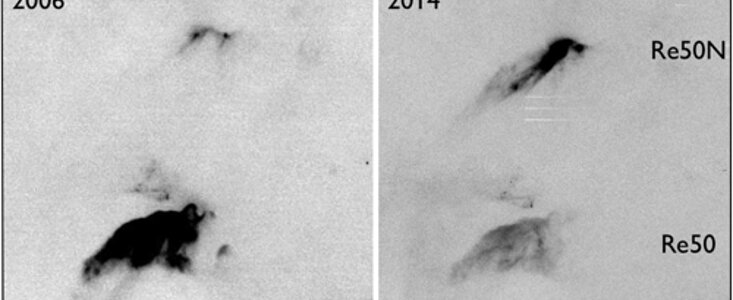Don’t Blink: A Light Show in a Dynamic Stellar Nursery
25 Marzo 2015
Changes in the universe don’t often happen on human timescales.
In the cosmic “blink of an eye,” astronomers have detected rapid changes in brightness and appearance of a restless stellar nursery in Orion. The luminous cloud of gas, going by the designation Re50, first appeared about half a century ago in the constellation of Orion. Now, astronomers using the Gemini South telescope, and other telescopes around the world, have discovered that the chaotic caldron has once again brightened further. According to team member Bo Reipurth, of the University of Hawaii’s Institute for Astronomy, “This most recent brightening, happened, I believe in 2014, when unfortunately we weren’t able to look since Orion was in the Sun’s glare.” Reipurth adds that areas of stellar birth, in this case called a Class I protostar, are extremely dynamic places and change on human timescales, “… while we missed the initial brightening event, we can still study the changes going on and learn a lot about what’s happening.” Based on the team’s observations, they conclude that curtains of obscuring material are likely casting patterns of illumination and shadows onto the molecular cloud that envelopes the nursery, “…which gives us a spectacular stellar light show!” says Reipurth.
Abstract
The luminous Class I protostar HBC 494, embedded in the Orion A cloud, is associated with a pair of reflection nebulae, Re50 and Re50N, which appeared sometime between 1955 and 1979. We have found that a dramatic brightening of Re50N has taken place sometime between 2006 and 2014. This could result if the embedded source is undergoing a FUor eruption. However, the near-infrared spectrum shows a featureless very red continuum, in contrast to the strong CO bandhead absorption displayed by FUors. Such heavy veiling, and the high luminosity of the protostar, is indicative of strong accretion but seemingly not in the manner of typical FUors. We favor the alternative explanation that the major brightening of Re50N and the simultaneous fading of Re50 is caused by curtains of obscuring material that cast patterns of illumination and shadows across the surface of the molecular cloud. This is likely occurring as an outflow cavity surrounding the embedded protostar breaks through to the surface of the molecular cloud. Several Herbig-Haro objects are found in the region.
Enlaces
- Learn more in the team’s paper, which is accepted for publication in The Astrophysical Journal, at: arXiv.org.


